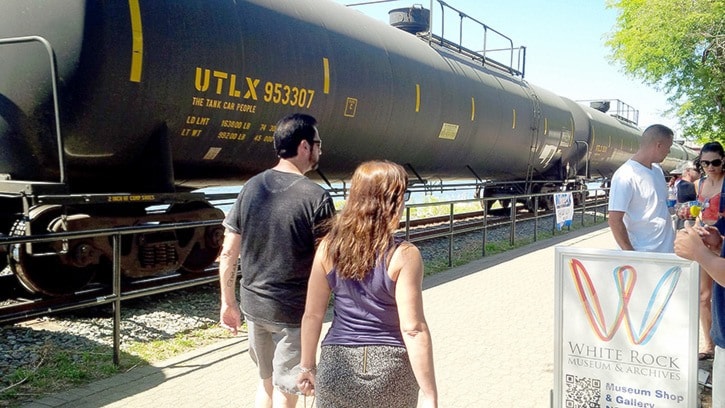White Rock Mayor Wayne Baldwin says it’s time to get the goal of relocating the waterfront railway back on track.
And a motion to be considered this evening, asking that staff be directed to initiate the process, is simply the first step in what will be a years-long exercise, he said.
“This has been sort of like our long-term goal,” Baldwin told PAN Friday, of wanting to reroute dangerous goods from the seaside line.
Initial discussion of the issue last summer was triggered by the devastating derailment in Lac Mégantic, Que. It was intensified by attention to the deteriorating condition of the Little Campbell rail bridge on Semiahmoo First Nation land.
While the focus on the goal was sidelined by a series of safety-related orders from Transport Canada to the city and railway owner BNSF – following the death of a jogger on East Beach tracks a week after the Quebec tragedy – Baldwin said the recent decision to green-light a new coal-transfer facility in Surrey spurred him to push the issue to the forefront.
“We’ve come to a conclusion (on the Transport Canada orders), now we can turn our attention to how to deal with the dangerous goods, which is to not have them at all,” he said. “What changed for me was the decision by Port Metro Vancouver to allow the Fraser Surrey Docks’ proposal to go through. That just kind of crystalized it – this is not going to go away.”
(Steps to abide by the Transport Canada orders are ongoing but so far include the installation of bollards at the West Beach boat launch and fencing of the west side of Bayview Park; chainlink meshing is to go up along the length of the promenade handrailing this fall; at-grade pedestrian crossings are to be leveled; and, ultimately, flashing lights and gates are to be installed.)
The $15-million Fraser Surrey Docks facility has been the source of much controversy since it was first proposed in September 2012. Once built, it will take at least four million tonnes per year of U.S. coal by train through White Rock and Surrey and send it by barge down the Fraser River to Texada Island for reloading to ocean-going ships.
It is expected to significantly increase train traffic through the Semiahmoo Peninsula – potentially by 320 trains in the first year alone – but Baldwin said Friday that when the new FSD facility is operational, “we might be looking at an extra eight trains a day.”
At a rail-safety forum hosted by the city in July, attendees heard that everything from crude oil to chlorine is already being transported along the waterfront.
Plans to replace the Massey Tunnel with a bridge – a move expected to increase shipping capacities on the Fraser River – only further the logic of moving the tracks, Baldwin said.
“You can see the future coming, and it’s not looking like less trains.”
Last year, Baldwin estimated the costs of moving the line at $350-400 million, not including any work south of the border.
In August 2013, staff from White Rock and the City of Surrey began researching the idea’s feasibility and preparing a business case.
Following a joint community forum with Surrey Mayor Dianne Watts in November, critics said it would simply move the problem from one neighbourhood to another. The following month, Surrey Coun. Mary Martin later said track realignment “will not happen… in the foreseeable future.”
A council resolution is needed to get the ball rolling again, Baldwin said, and he hopes counterparts in Surrey will follow suit. Steps to follow will include getting all of the stakeholders involved and approaching the Ministry of Transportation for approval.
“It’s going to be a long process, but it has to start somewhere and that’s a good first step.
“We have nothing to lose by it.”
